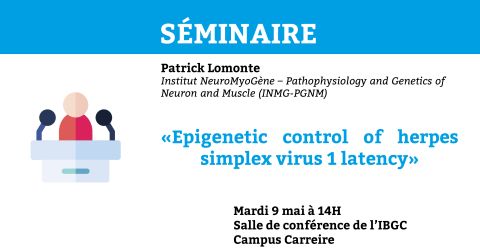Patrick Lomonte
Univ Lyon, Université Claude Bernard Lyon 1, CNRS UMR 5261, INSERM U1315, LabEx DEV2CAN, Institut NeuroMyoGène-Pathophysiology and Genetics of Neuron and Muscle (INMG-PGNM), team Chromatin dynamics, Nuclear Domains, Virus. F-69008, Lyon, France
"Epigenetic control of herpes simplex virus 1 latency"
The establishment of latent herpes simplex virus 1 (HSV-1) infection involves a complex interplay of cellular and molecular events. At the epigenetic level, this requires the viral chromatinization and interaction of latent episomal viral genomes with their nuclear environment. Promyelocytic leukemia nuclear bodies (PML NBs also named ND10) are nuclear membrane-less organelles involved in the transcriptional control of HSV-1 latent genomes. The protein composition of PML NBs is highly dynamic due to their phase separation properties. Following HSV-1 nuclear entry, PML NBs sequester HSV-1 genomes and control the acquisition of repressive histone marks of PML NBs-associated HSV-1 genomes (also named viral DNA-containing PML NBs, vDCP NBs). VDCP NBs, a major hallmark of HSV-1 latently infected neurons, are characterized by their ability to maintain latent HSV-1 genomes in a transcriptionally inactive, but reversible, state of quiescence. We recently identified an essential role for the HUSH (human silencing hub) complex and its SETDB1 and MORC2 effectors in the establishment and maintenance of latent herpes simplex virus 1 (HSV-1) infection. During my seminar I will give an insight of the epigenetic control of HSV-1 latency, and the specific role of the HUSH repressor complex.


